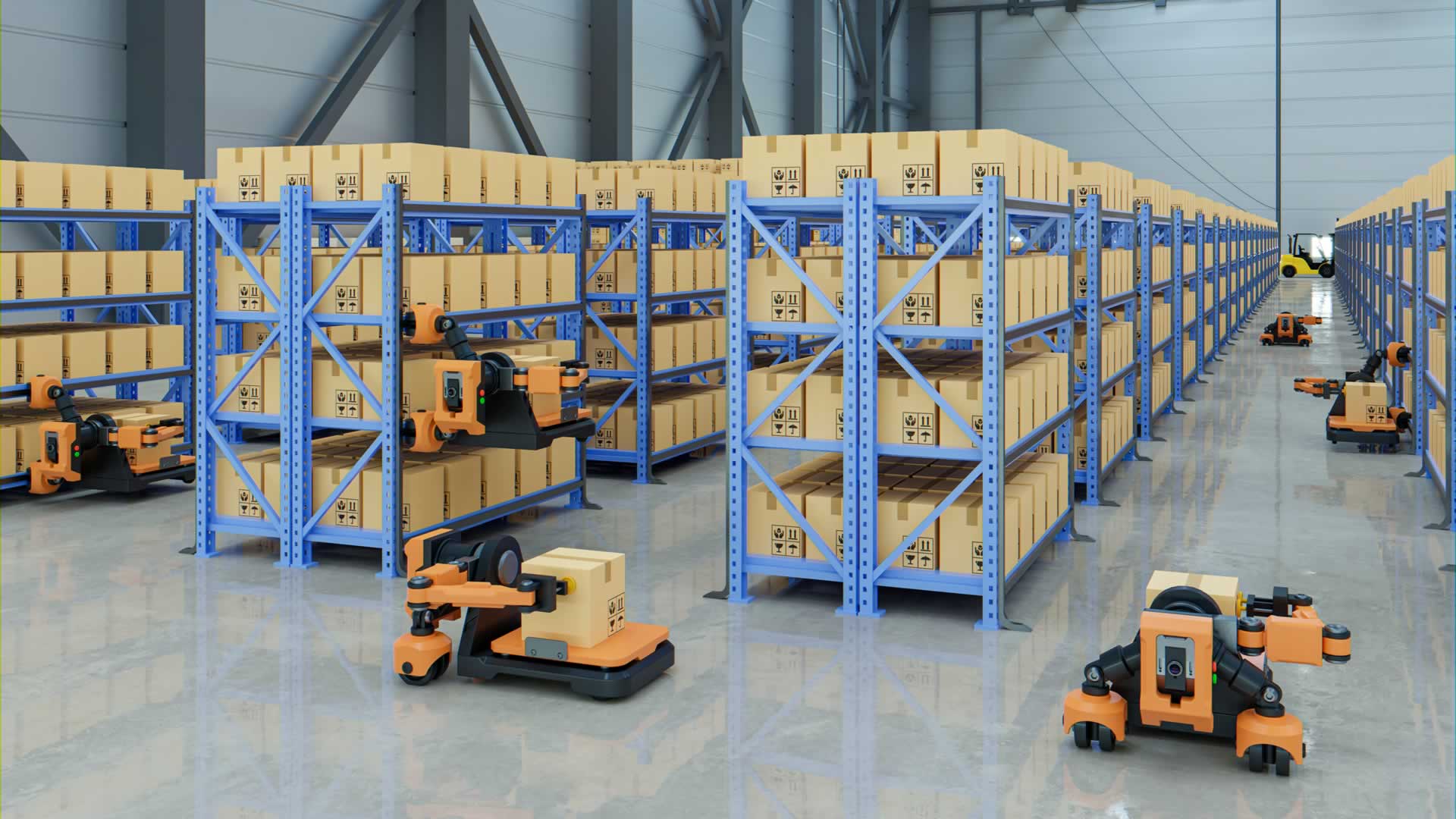
Rapid growth and increasing demands drive the current warehousing landscape characterized by e-commerce expansion, globalization, and consumer expectations for fast and efficient order fulfilment. Traditional warehouse management systems (WMS) often face several challenges in meeting these evolving demands. Here are some key challenges faced by conventional warehouse management systems that can be solved by integrating robotics into WMS:
- Manual and Paper-based Processes
- Lack of Real-time Visibility
- Inefficient Space Utilization
- Limited Scalability
- Inaccurate Forecasting and Planning
- Lack of Automation
- Integration Challenges
Businesses increasingly turn to innovative solutions such as integrating robotics, automation, and advanced warehouse management systems that offer real-time visibility, scalability, efficiency, and enhanced decision-making capabilities.
The Role of Robotics in Warehousing
The robotics applications in the warehousing industry are diverse and can significantly enhance various aspects of warehouse operations. Here are some critical applications of robotics in warehousing:
Picking and Packing
Robotic systems can automate the picking and packing of items in a warehouse. This system involves robots navigating the warehouse aisles, locating the designated items, and retrieving them for order fulfillment. They can then package the items efficiently, ensuring accuracy and reducing the time required for these tasks. Robotic picking and packing systems can handle a wide range of products, from minor to larger ones, contributing to increased efficiency and order accuracy.
Sorting and Conveyor Systems
In sorting operations, businesses utilize robotics to sort packages or items based on specific criteria such as destination or order priority. Robots with sensors and advanced vision systems can quickly and accurately identify and sort things. Robots can seamlessly handle high volumes of packages, significantly improving sorting speed and minimizing errors when integrated with conveyor systems.
Inventory Management
Robotic systems can assist inventory management, including cycle counting, stocktaking, and replenishment. By utilizing robots equipped with barcode scanners or RFID technology, warehouses can automate scanning and tracking inventory. This automation improves accuracy, eliminates the need for manual counting, and provides real-time inventory visibility, enabling more effective inventory control and reducing stockouts.
Autonomous Mobile Robots (AMRs)
AMRs are self-navigating robots that can move independently within a warehouse environment. These robots can transport items, materials, or inventory from one location to another, minimizing the need for manual material handling and reducing labor-intensive tasks. AMRs can optimize travel routes, adapt to changing warehouse layouts, and collaborate with human workers to streamline operations and improve productivity.
Collaborative Robots (Cobots)
Cobots work alongside human workers, assisting them in various warehouse tasks. These robots have advanced safety features and can handle tasks requiring strength, precision, or repetitive movements. Cobots can support warehouse workers in lifting heavy items, loading and unloading, or performing intricate assembly tasks, ultimately enhancing worker safety and productivity.
Robotic Warehouse Optimization
Beyond specific applications, robotics can contribute to overall warehouse optimization. By integrating robots with intelligent warehouse management systems (WMS), businesses can achieve real-time data visibility, optimize storage space, automate workflows, and improve overall operational efficiency. Robotics can also enable predictive analytics, allowing warehouses to anticipate demand patterns, optimize labor resources, and streamline order fulfillment processes.
These various robotics applications in the warehousing industry offer significant advantages, including increased speed, accuracy, efficiency, and scalability. They optimize operational processes and enable warehouses to handle growing volumes, improve customer satisfaction, and adapt to the ever-evolving demands of the modern supply chain.
Impact on Workforce and Job Roles
The evolving nature of warehouse job roles is undergoing significant changes as the adoption of robotics and automation grows. While robots are employed to handle repetitive and physically demanding tasks, the collaborative relationship between humans and robots is becoming increasingly important. Here’s a discussion on how job roles are evolving and the cooperative dynamics between humans and robots in warehouses:
The shift from Manual to Cognitive Skills
With the introduction of robots, the emphasis on job roles is shifting from manual labor to more cognitive skills. Instead of focusing on mundane and physically demanding tasks like repetitive picking or heavy lifting, human workers now perform higher-level tasks that require problem-solving, decision-making, and critical thinking abilities. This shift allows human workers to utilize their skills and expertise to handle complex situations, manage exceptions, and oversee operations.
Adaptation and Training
As warehouse operations integrate robots, workers must adapt to new roles and acquire skills to collaborate effectively with robots. Companies are developing training programs to educate workers on robot operation, maintenance, troubleshooting, and safety protocols. This adaptation empowers workers to become robot operators, supervisors, or coordinators, ensuring smooth coordination and interaction between humans and robots.
Human-Robot Collaboration
Warehouses are becoming environments where humans and robots work side by side, complementing each other’s strengths. Humans possess cognitive abilities, adaptability, and intuition, while robots excel at repetitive, precise tasks, speed, and endurance. Collaborative tasks involve humans and robots working together, such as guiding robots, monitoring operations, quality control, and handling exceptions that require human judgment. This collaboration optimizes the strengths of both parties and enhances overall operational efficiency.
Enhanced Safety and Ergonomics
The introduction of robots in warehouses aims to improve worker safety and ergonomics. Robots handle physically demanding tasks, reducing the risk of injuries for human workers. Collaborative robots, known as cobots, are equipped with advanced safety features that allow humans to work alongside them without endangering their well-being. By offloading physically strenuous tasks to robots, workers can focus on tasks that require their expertise while minimizing physical strain.
Skill Upgrading and Job Satisfaction
Integrating robots allows workers to upgrade their skills and engage in more fulfilling and challenging roles. By shifting from manual tasks to cognitive responsibilities, workers can develop new competencies, expand their knowledge, and enhance their value within the warehouse. This integration can increase job satisfaction, career growth, and the ability to perform more meaningful and intellectually stimulating work.
Adaptability to Technological Advancements
The collaborative relationship between humans and robots prepares the workforce for future technological advancements. As robotics and automation technologies continue to evolve, workers who have experience collaborating with robots are better positioned to adapt to new technologies and contribute to their integration in warehouse operations. The ability to adjust and work collaboratively with evolving technologies ensures the workforce remains competitive and resilient in an ever-changing job market.
In summary, the evolving nature of warehouse job roles emphasizes a collaborative relationship between humans and robots. By capitalizing on the strengths of each, workers can transition to more cognitive tasks, enhance safety and ergonomics, and experience increased job satisfaction. The collaborative dynamics between humans and robots optimize operational efficiency and prepare the workforce for future technological advancements in warehousing and beyond.
Request a Demo
Need more information?
Solutions






![image001[25]](https://www.royal4.com/wp-content/uploads/2023/11/image00125.png)